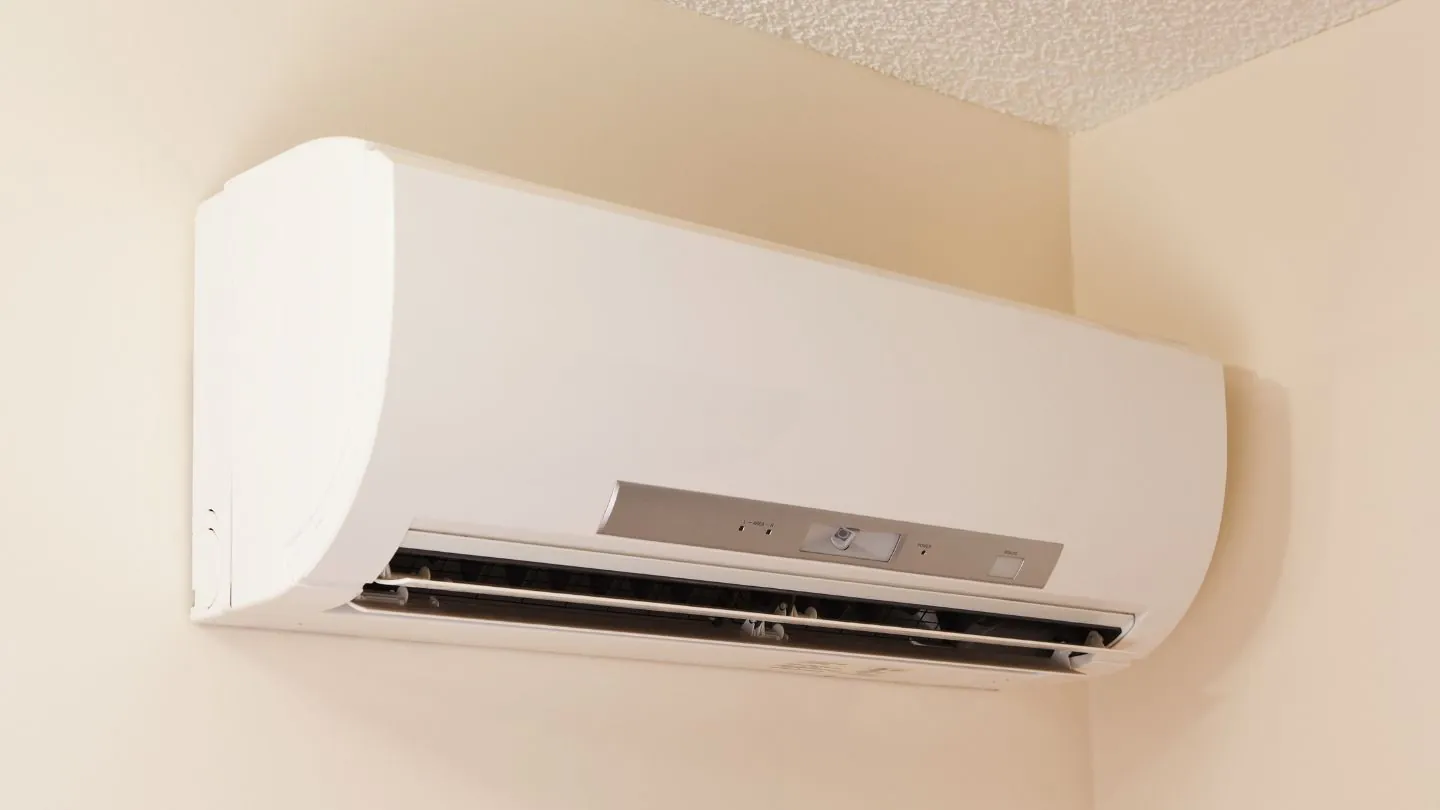How Does a Ductless Mini Split Air Conditioner Work?
A ductless mini split air conditioner cools and heats your home without ductwork. It uses an outdoor unit and one or more indoor units connected by refrigerant lines. This guide will explain each component and show you how a ductless mini-split air conditioner works efficiently.
Key Takeaways
- Ductless mini-split systems are energy-efficient alternatives to traditional HVAC systems, providing both heating and cooling without the need for ductwork.
- These systems allow for customizable temperature control in individual rooms, enhancing comfort and improving indoor air quality with advanced filtration technology.
- Installation options are versatile, with wall-mounted, ceiling-mounted, and floor-mounted units available, making them suitable for various home layouts.
Understanding Ductless Mini Split Systems
A ductless mini-split system is a versatile solution for heating and cooling that doesn’t rely on any ductwork. This feature renders it especially suitable for older residences or remodels where the installation of traditional ducting would be challenging or excessively expensive. In contrast to central air systems, which cool an entire house via a network of ducts, mini-split systems allow precise temperature management in designated zones or rooms, offering superior energy efficiency and customization options. These characteristics make them advantageous in numerous situations.
The components of these systems include an outdoor compressor unit connected through refrigerant lines to one or more indoor units situated within different areas of the home. Many mini-split models can operate as heat pumps, thus providing both cooling and heating capabilities—an attribute that significantly enhances their utility across all seasons.
Ductless AC has established its foothold with over 1.75 million American households already integrating this technology into their homes—a number that continues to rise each year—evidently indicating the staying power and popularity of these solutions in modern-day climate control applications.
Key Components of Ductless Mini Splits
A ductless mini-split system is primarily comprised of an indoor unit and an outdoor unit connected by refrigerant lines. The compressor and condenser coils within the outdoor unit work to expel heat from the refrigerant.
The evaporator coils are located in each indoor unit inside your home. These coils extract heat from the air to convert the refrigerant into a gas, effectively cooling the space. Alongside this process, drain lines and electrical cables combine with the refrigerant lines to create what’s known as a line set – a vital component necessary for the functionality of the mini-split system. A licensed HVAC professional ensures this setup is sealed, insulated, and routed correctly to maintain system performance and avoid energy loss.
Single-Zone vs. Multi-Zone Systems
Mini-split systems are available in two primary setups: single-zone and multi-zone. The single-zone configuration is crafted to provide heating and cooling to a singular area, making it suitable for just one room.
On the other hand, a multi-zone ductless mini-split system allows for temperature regulation across various rooms through the connection of several indoor units to one outdoor unit. This arrangement’s main benefit lies in its capacity to maintain distinct temperatures within each connected space, thereby increasing comfort levels and operational efficiency.
Nevertheless, establishing a multi-zone system requires meticulous handling of extended refrigerant lines so as to preserve both safety standards and energy efficiency.
How Ductless Mini Split Air Conditioners Work

Ductless mini-split air conditioners present an efficient solution for regulating the temperature within your residence. They are engineered to deliver heating and cooling capabilities while eliminating the necessity of ducts. The core elements of these systems consist of an outdoor unit, multiple indoor units as needed, lines containing refrigerant, and electrical wiring.
Using less energy by transferring heat instead of generating cold air directly makes ductless mini-splits a potent option for maintaining comfort in homes regardless of size. Each individual unit is adjustable with a remote control. The capacity of these air conditioners is determined by British Thermal Units (BTUs), ensuring that every system can be precisely matched to the requirements of the designated area it serves.
Read more: How Ductless Air Conditioners Enhance Home Comfort
Cooling Process
The operation of a ductless mini-split system’s cooling mechanism is straightforward and effective. The process starts within the indoor unit, where refrigerants draw in heat and moisture from the surrounding air, transforming into a gaseous state. This collected heat energy is then transferred outdoors via refrigerant lines that contain super-chilled liquid.
After discharging the heat outside, the now-cooled air circulates back into the indoor environment, ensuring an even and pleasant temperature. Professional HVAC technicians ensure optimal airflow direction and system calibration during installation to maximize cooling efficiency.
Read more: Do Mini Splits Heat And Cool Your Home Efficiently?
Heating Functionality
Ductless mini split systems are renowned for their dual functionality as both a heating and cooling system, offering an efficient solution for temperature regulation throughout the year. By inverting the process used to cool air, these systems have the capability to transfer heat energy indoors when temperatures drop.
This advanced technology operates by relocating existing warmth from outside into your home rather than generating new heat. In colder regions or during winter months, HVAC professionals may install protective covers or place units on raised platforms to ensure consistent operation, even in snowy or icy conditions.
Energy Efficiency
Ductless mini-split systems have gained recognition for their superior energy efficiency. They circumvent the common problem of energy loss encountered with traditional ducted systems, which is often attributed to duct leakage. These systems also empower users with the ability to tailor temperature settings for each room individually, thereby reducing unnecessary energy consumption.
Additionally, mini splits use inverter-controlled variable-speed compressors that adapt to real-time demands, helping maintain consistent indoor temperatures while using only the energy necessary. When installed and maintained by a qualified HVAC contractor, this advanced system design contributes to lower monthly energy costs and long-term savings.
Installation Options for Ductless Mini Splits

Ductless mini-split systems offer a range of flexible installation choices, setting them apart from traditional ducted HVAC systems. These mini splits necessitate merely modest openings to accommodate the piping connections, simplifying their integration into structures that lack pre-existing ductwork.
Mini split systems provide diverse placement options, such as being mounted on walls, ceilings, or floors. Typically, their corresponding outdoor condenser units are positioned either on concrete pads or elevated on stilts to guarantee they operate efficiently.
To ensure these ductless mini splits perform at their best, it’s imperative to engage a skilled HVAC professional for proper installation.
Read more: Choosing Between Ductless AC VS. Central AC
Wall-Mounted Units
The predominant variety of indoor units within ductless mini-split systems, commonly called mini-split heads, are those that mount on walls. Positioned high up on a wall, they excel at delivering localized cooling or heating to specific rooms.
Due to their straightforward installation and upkeep requirements, these wall-mounted units are favored in many residential applications. Proper placement and calibration by an HVAC professional ensure optimal airflow and balanced temperature distribution across the room.
Ceiling-Mounted Units
Units mounted on the ceiling provide a substitute for those affixed to walls, excelling in ample areas or interiors featuring elevated ceilings. They blend effortlessly into the ceiling area, offering an unobtrusive presence alongside an extensive reach of airflow.
Such units are perfectly suited for spaces with open floor layouts and contribute to preserving wall space, which enhances the potential for creative design within a room.
Floor-Mounted Units
Units mounted on the floor present an alternative flexible method for setting up ductless mini-split systems. Positioned at ground level, they are apt for areas that have limited ceiling height or in situations where mounting them to walls or ceilings is impractical, such as in basements and attics.
Such floor-mounted units provide effective dispersion of temperature and enhance the use of space, which renders them a sensible option for spaces with distinct configurations.
Advantages of Ductless Mini Split Systems

Mini-split systems offer a considerable range of benefits, making them an attractive option for property owners. These units are capable of providing both heating and cooling capabilities, delivering flexible climate control solutions suitable for all seasons. Mini-splits stand out for their exceptional energy efficiency, which can lead to lower energy usage and a reduced environmental impact.
The installation flexibility of ductless mini splits makes them ideal for diverse environments while enhancing the comfort level within your home.
Individual Room Control
Ductless mini-split systems offer a major benefit in that they grant the ability to regulate temperatures within separate rooms. Every indoor unit has the flexibility to be adjusted to varying temperatures, offering tailored comfort and guaranteeing steady heating and cooling across the household.
For example, in homes where family members have different comfort preferences, an HVAC expert can zone the system so each individual room or area can operate independently. This also contributes to better energy savings by avoiding unnecessary heating or cooling of unused spaces.
Improved Air Quality
Advanced filtration technology in ductless mini-split systems plays a pivotal role in enhancing indoor air quality. These systems come with multi-stage filters within each indoor unit, which are effective at capturing airborne contaminants like dust, allergens, and bacteria.
Unlike central systems, ductless mini-splits reduce the risk of pollutants circulating through shared ductwork. HVAC professionals can recommend filter upgrades or regular cleaning schedules based on your home’s environment, helping to maintain cleaner, healthier indoor air.
Quiet Operation
Mini split systems, known for their silent functioning, serve as an outstanding substitute for conventional HVAC systems. The indoor units of ductless mini-split systems work at sound levels similar to a gentle murmur, guaranteeing that your residence maintains its tranquility and comfort with both individual mini-split units and the overall mini-split system.
Such low noise levels are particularly valued in spaces like bedrooms and home offices where quiet is essential, as well as any other areas where unwelcome sounds might be disruptive.
Common Concerns and Solutions
Potential buyers frequently express apprehensions regarding the upfront cost, appearance, and upkeep demands of ductless mini-split systems.
By tackling these issues and presenting practical solutions, homeowners are able to make knowledgeable choices.
Initial Cost
The initial expense of ductless mini-split systems is often seen as a drawback since they are around 30% more expensive to install than traditional HVAC systems. The average installation fee for a ductless mini split air conditioner hovers at about $3,000.
However, over time, homeowners typically recover the cost through improved energy efficiency and lower utility bills. Additionally, many local and federal energy programs offer rebates or incentives for installing energy-efficient HVAC systems. A professional contractor can help identify and apply these cost-saving opportunities during system selection.
Aesthetic Considerations
Some homeowners may feel that ductless mini-split units impact their interior design. However, today’s systems are available in sleek, modern styles that can complement a variety of decors. HVAC professionals can offer guidance on discreet placement or low-profile unit designs to help the system blend seamlessly into the home’s aesthetic.
If appearance is a concern, experts may suggest recessed ceiling units or custom enclosures that maintain airflow without disrupting the room’s style.
Maintenance Requirements
To ensure efficient functioning, ductless mini-split systems require minimal but regular maintenance. This includes cleaning or replacing filters, checking for refrigerant leaks, and inspecting electrical connections.
Instead of attempting DIY maintenance, it’s best to schedule routine professional service. HVAC technicians are trained to clean coils, check pressure levels, and ensure the system runs at peak efficiency. Regular service appointments help prevent breakdowns and extend the system’s lifespan.
Choosing the Right System for Your Home
When selecting an appropriate ductless mini-split system, it is essential to evaluate the particular requirements of your home and engage with HVAC experts who can offer customized solutions that enhance the efficiency of your home’s heating and cooling.
Due to the intricate nature involved in setting up a mini-split system, partnering with a knowledgeable HVAC technician is vital for ensuring the installation is executed correctly, guaranteeing maximum functionality and performance. Professionals will also help match unit capacity (in BTUs) to your space, considering factors like layout, insulation, and local climate.
Assessing Your Home’s Needs
When choosing a ductless mini-split system for your home, it is essential to consider various elements that will influence its effectiveness. The quality of the insulation, the dimensions of the rooms, the number of windows there, and the typical weather conditions all play significant roles in this decision.
To guarantee that you select a mini-split system tailored to your specific heating and cooling demands, it’s advisable to consult with an HVAC expert who can conduct a precise load calculation based on these factors.
Professional Consultation
When contemplating the installation of a ductless mini-split system, it is crucial to seek advice from an HVAC expert. These professionals can evaluate your home’s unique requirements, taking into account the structure’s design and possible energy inefficiencies, in order to suggest the most appropriate ductless mini.
It’s important when choosing an HVAC contractor for your mini split to verify they hold valid licenses and insurance policies. Examining past customer reviews can help you assess their dependability and quality of service. Consulting with a professional ensures that your ductless mini-split system will be installed accurately and effectively, providing you with added confidence in its operation.
Summary
Ductless mini-split systems offer a modern and versatile method of controlling your home’s climate, providing both heating and cooling solutions. They are engineered to enhance energy efficiency and improve indoor air quality. With various installation options and the ability to control temperatures in individual rooms, mini splits cater to a broad spectrum of comfort needs. Although the initial costs may be higher, the long-term savings and benefits make ductless mini-splits a valuable investment for homeowners. Along with ductless AC, we provide Furnace Repair Services, Heat Pump Installation, and Commercial HVAC services.
At Total Comfort Cooling & Heating Inc., we specialize in ductless AC in Port Charlotte, offering expert installation and maintenance services. Rely on us to assist you in choosing the perfect system for your home’s comfort, efficiency, and lasting performance. Contact us today to explore how we can enhance your indoor climate!
Frequently Asked Questions
Can ductless mini splits help with humidity control?
Yes, ductless systems naturally reduce indoor humidity as they cool, making them effective in humid climates.
Do mini-split systems work during power outages?
Like traditional HVAC systems, they won’t function without power. A backup generator can keep them running during outages.
How long does a ductless mini-split system typically last?
With regular professional maintenance, mini splits can last 15 to 20 years or more.
READY FOR YOUR NEXT HEATING OR COOLING PROJECT?
Contact us to get a quote and see why our customer service is recognized as the best in the industry.







 Special Offer: 12 Months - No Interest, No Payments!
Special Offer: 12 Months - No Interest, No Payments!